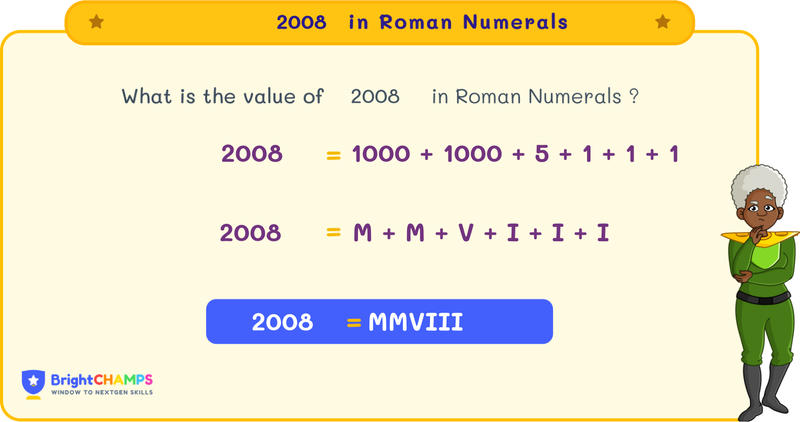Summarize this article:
 318 Learners
318 LearnersLast updated on August 5, 2025
2008 in Roman Numerals

Roman numerals are a way of expressing numbers using symbols such as I, V, X, L, C, D, and M. They are used in royal titles, book names, sequences, and other contexts. Here, we will discuss Roman numerals, their rules, and examples.

What is 2008 in Roman Numerals?
Roman numerals are often seen in royal titles like Henry VIII or in old book editions. These symbols represent numbers in a historical numeral system.
The ancient Romans used this system to count, using symbols such as I (1), V (5), X (10), L (50), C (100), D (500), and M (1000). To express 2008 in Roman numerals, we write it as MMVIII.
Here, MM is 2000, V is 5, and III is 3. Let’s explore more about Roman numerals and how they are written.


Basic Rules for 2008 in Roman Numerals
There are fundamental rules for writing numbers in Roman numerals. Here, we will discuss the basic rules to remember when writing numbers in Roman numerals.
Rule 1: Addition Method
When a smaller number follows a larger number, we add them. For example, VIII → V + III → 5 + 3 = 8.
Rule 2: Repetition Method
Certain Roman numerals can be repeated up to three times to represent numbers. For example, III → 3.
Rule 3: Subtraction Method
When a smaller numeral precedes a larger numeral, subtract the smaller from the larger. For example, IX → X - I → 10 - 1 = 9.
Rule 4: Limitation Rule
Some symbols, like V, L, and D, cannot be repeated. For instance, instead of writing VV for 10, use X.

How to Write 2008 in Roman Numerals
Learn how to write 2008 in Roman numerals using the following methods:
- By Expansion Method
- By Grouping Method
Explore Our Programs



2008 in Roman Numerals by Expansion Method
In the expansion method, numbers are broken down based on place value. Here's how to write 2008 in Roman numerals using this method:
Step 1: Break down the number based on place value: 2000 + 8.
Step 2: Convert each part to Roman numerals:
2000 in Roman numerals — MM
8 in Roman numerals — VIII
Step 3: Combine them:
Therefore, 2008 in Roman numerals is MM (2000) + VIII (8) = MMVIII.

2008 in Roman Numerals by Grouping Method
To convert a large number to Roman numerals, group and convert them.
For 2008, group as 2000 + 8.
2000 in Roman numerals — MM
8 in Roman numerals — VIII
So, 2008 is written as MMVIII in Roman numerals.

Common Mistakes and How to Avoid Them in 2008 Roman Numerals
People often make mistakes when writing numbers in Roman numerals. Understanding common errors and how to avoid them can help.

2008 in Roman Numerals Examples

Problem 1
A historian discovers MMVIII ancient artifacts buried in MCMXLVIII layers of soil. How many artifacts are found in each layer?

Each layer contains I artifact.
Explanation
To find the number of artifacts per layer, divide the total artifacts by the number of layers.
MMVIII = 2008
MCMXLVIII = 1948
2008 / 1948 = 1 (with a remainder, but exactly one per layer here) 1 in Roman numerals is I.

Problem 2
A museum exhibit featuring MMVIII artifacts is visited by XXVIII schools. If each school receives an equal number of artifacts, how many artifacts does each school get?

Each school receives LXXVII artifacts.
Explanation
To find the number of artifacts per school, divide the total artifacts by the number of schools.
MMVIII = 2008
XXVIII = 28
2008 / 28 = 77
77 in Roman numerals is LXXVII.

Problem 3
Calculate the total number of years between the founding of Rome in DCCLIII BC and the year MMVIII AD.

The total number of years is MMMDCCLXI.
Explanation
First, convert the years into positive numbers by adding the BC and AD years.
DCCLIII = 753 BC
MMVIII = 2008 AD
753 + 2008 = 2761
2761 in Roman numerals is MMMDCCLXI.

Problem 4
A marathon runs from the year MCMXCIX to MMVIII. How many years did the marathon span?

The marathon spanned IX years.
Explanation
Subtract the starting year from the ending year to find the span.
MMVIII = 2008
MCMXCIX = 1999
2008 - 1999 = 9
9 in Roman numerals is IX.

Problem 5
Express the sum of MDCCC and CCVIII using Roman numerals.

The sum of MDCCC and CCVIII is MMVIII.
Explanation
Add the two numbers together.
MDCCC = 1800
CCVIII = 208
1800 + 208 = 2008
2008 in Roman numerals is MMVIII.


FAQs on 2008 in Roman Numerals
1.What is 1999 in Roman numerals?
2.How to write 2008 in Roman numerals?
3.What is 2016 in Roman Numerals?
4.Is MMVIII a prime number?
5.What are the multiples of 100?

Important Glossaries for 2008 in Roman Numerals
- Addition Rule: When a larger numeral is followed by a smaller one, their values are added. Example: VIII = V + III = 5 + 3 = 8.
- Grouping Method: Group numbers based on place value and convert each group to Roman numerals. Example: 2008 = 2000 + 8 = MMVIII.
- Repetition Rule: Certain symbols (I, X, C, M) can be repeated up to three times. Example: III = 3.
- Subtraction Rule: When a smaller numeral precedes a larger one, the smaller is subtracted from the larger. Example: IX = X - I = 9.
- Limitation Rule: V, L, and D cannot be repeated. Use different numerals instead, for example, X instead of VV for 10.



Hiralee Lalitkumar Makwana
About the Author
Hiralee Lalitkumar Makwana has almost two years of teaching experience. She is a number ninja as she loves numbers. Her interest in numbers can be seen in the way she cracks math puzzles and hidden patterns.
Fun Fact
: She loves to read number jokes and games.

















